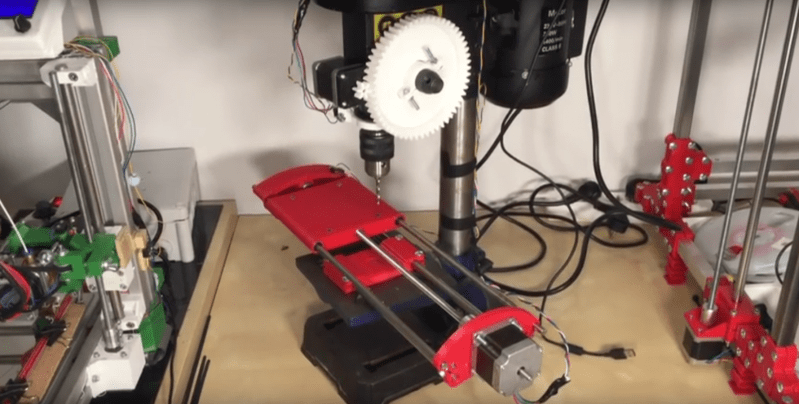He’s a little cagey about the reasons, but [Ivan Miranda] plans to put a drill press on the internet. What could go wrong with that?
We’ll take [Ivan] at his word that there’s a method to this madness and just take a look at the build itself, in the hopes that it will inspire someone to turn their lowly drill press into a sorta-kinda 2-axis milling machine. [Ivan] makes extensive use of his 3D printer to fabricate the X-axis slide that bolts to the stock drill press table. And before anyone points out the obvious, [Ivan] already acknowledges that the slide is way too flimsy to hold up to much serious drilling, especially considering the huge mechanical advantage of the gearing he used to replace the quill handle for a powered Z-axis. The motor switch was also replaced with a solid state relay. The steppers, relay, and limit switches are all fed into a Teensy that talks to an ESP8266, which will presumably host a web interface to put this thing online.
The connected aspects of the drill press become a little more clear after the break.
https://www.youtube.com/watch?v=in7QHbu4Z2U
Turns out [Ivan] had a sort of an Internet performance art piece in mind, wherein visitors to his website would get to vote on which of two phones would be executed by lethal drill pressing. The ways in which this project failed were manifold, from website errors that let the first visitor select a phone within eight minutes of going live, to inability of the stepper to drive the quill, to the surprisingly sturdy screens on the cheap phones. Oh well, these failures are a great satirical representation of the ills IoT has in its near future.
https://www.youtube.com/watch?v=OF6p4QQ3iG8
Perhaps you’ll enjoy these other drill press tricks, like turning a drill press into a spindle sander, or even giving a benchtop press a column transplant to allow bigger workpieces.
[via r/Arduino]















add tag: fail
How long until somebody uses the drill bit to drill through the ways of the machine? At least when twitch plays something, the masses can handle some noise for most games. Subtractive machining? Not as much.
Could see this becoming big if it plays the opposing motivations of fanboys off against each other for internet drama, regular viewership and ad revenue. Nice if you can just leave it run (like an idle game) and it makes something people are hooked watching while you do something else.
Ahh, so Arduino ‘vs’ NE555?
Nah, should have been iPhone v. Android
Pretty much the same, and Android is comparable to a 555 :)
Twitch plays Drill Press!
Drill presses are NOT capable of side loading. If you put to much pressure on it, the bearings will give out. This is very dangerous. Amy machinist will tell you the same thing. DO NOT DO THIS!
Depends totally on how much load you put on it, and what kind of bearings the drill has. The cheap drill press at our hacklab actually only has a pair of normal cartridge bearings.. so I would rate it as “not suitable for drilling operations either” :)
Based on the video, it does not look like he is side loading the drill at all.
Worse is that the spindle isn’t really designed for the fatigue of side loads. I expect that in low cost drill presses the spindle will break long before the bearings fail; the bearings are capable of a lot of thrust load. I expect their radial load capacity is similarly high. OTOH fully reversing bending loads on a cheap steel rod with a step in the shaft as a stress concentration? Spindle will lose that fight pretty easily.
Whoa, mind blown, just found IoT perfectly explained… unfortunately I can’t find the clip online, it’s on Netflix here…
Buffy The Vampire Slayer, Season 4, Episode 22, @ 35mins (On Netflix, don’t know if DVD or other media will be quite same spot) … bear in mind original airdate of May 23rd 2000, they been planning this since before 9/11 !!! :-D
Spoiler, here’s the core quote…
http://the-z-continuum.livejournal.com/100778.html
Supposedly we’ve seen substantial botnets that exploit security flaws in IoT devices. I forget what DDoS they supposedly were used in. And it’s going to get worse before it gets better.
I fear for the main bearing in this thing. Not meant for milling operations
Based on the video, it does not look like he is using it for any type of milling.
I have one of these el-cheapo drill presses and the main bearing is made of jello mixed with sand and iron filings.
They are also, what, $75 delivered? Harbor freight quality “tool”.
I have a different currency here but it was a little less than $75USD in an auto store.
I can grab the chuck and move it a small distance (1-2mm) laterally. I did that after finding inaccuracies in some machine parts that I made. As it turned out the inaccuracy wasn’t with the part that I made but a part (planetary reduction stepper motor) that I bought. The screw hole locations wasn’t to spec.
I also found an ‘adjustment’ that places more force on the sliding part holding the chuck. I will pull it apart some time and see if there may be a ‘fix’ to get decent bearings in there.
Sorry, my brain pattern recognition read that as “Building an idiot drill press for reasons unknown”.
+1
It’s amusing how there’s no hint of the author using this for milling but people then seem to assume it’s for milling and say it’s not a good way to do milling.